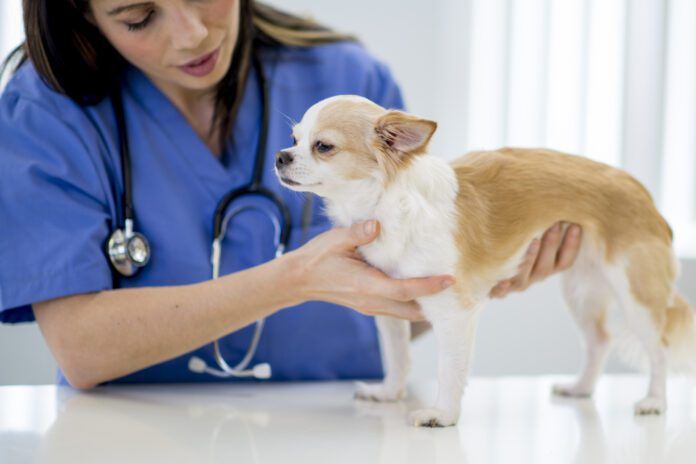
If your dog is pooping blood, he should be evaluated by a veterinarian as soon as possible, because some reasons for bloody diarrhea and vomiting are serious, such as a clotting disorder. There are also simple and straightforward causes for a dog’s stool to contain blood, even if he’s acting completely normal otherwise. After taking a history, including questions about any other symptoms the dog may be having, such as diarrhea or vomiting, and conducting a physical examination, the veterinarian will recommend a diagnostic and treatment plan.
Causes for pooping blood and diarrhea
Inflammatory colitis causes chronic diarrhea, sometimes accompanied by bloody stool. An infection or food intolerance may cause damage to the mucosa (the inner lining of the colon), resulting in the development of scar tissue and ulcers. Ulcers and scar tissue impair the colon’s ability to absorb water and increase the muscular contractions of the colon, resulting in diarrhea that is sometimes bloody with an increased urgency to defecate.
It may appear that your dog is pooping blood clots. This is likely blood mixed with thin layers of the ulcerated mucosa due to inflammation.
An infection with an intestinal parasite called whipworm can cause diarrhea that is streaked with blood and mucus. Your veterinarian may want to submit a sample of your dog’s feces to a laboratory for a fecal analysis to look for whipworm eggs. Bring a stool sample with you to your dog’s veterinary appointment, if possible. Because whipworm eggs are not shed in the feces all the time, it may take a few consecutive fecal analyses or the submission of a diarrhea panel to diagnose whipworm. If whipworm is suspected, then your dog may be prescribed a broad-spectrum dewormer, such as Drontal or Panacur. Most monthly heartworm preventatives are also effective at treating and controlling whipworm infections.
Certain bacterial and fungal infections can cause bloody diarrhea. Bacterial colitis infections with Campylobacter and Salmonella can result from consuming undercooked meat or drinking from contaminated water sources. Salmonella infections are seen more often in dogs who eat a raw food diet. A bacteria called Clostridium perfringens can produce toxins that may result in bloody diarrhea. These bacteria and the clostridium toxins can be detected on a special fecal test called a diarrhea panel. Histoplasmosis is a fungal infection that can cause bloody poop. It is caused by a fungus found in soil contaminated with bird or bat manure and is most prevalent in the Mississippi and Ohio River valleys. Histoplasma capsulatum can often be found on a sample taken from the wall of the rectum.
Blood in poop with vomiting
Parvovirus is a life-threatening viral infection that typically affects young puppies and adult dogs who have either never been vaccinated for parvovirus or have had an incomplete vaccination series. Puppies and dogs infected with parvovirus will often have bloody diarrhea, vomiting, and will be lethargic and not want to eat or drink. A rectal swab test is effective at identifying parvovirus but may be negative in the early stage of the disease. Parvo is a serious illness, so your veterinarian will likely recommend hospitalizing your pup for treatment.
Other causes of bloody poop
One of the simplest causes for this condition is an anal sac infection. Dogs have two anal sacs, located just behind their anus, which are lined with glands that produce a foul-smelling liquid. When a dog has a bowel movement, the stool applies pressure to the sacs as it passes through the rectum, pressing the liquid contents of the anal sacs onto the surface of the stool. When an anal sac becomes infected, there is increased blood flow to the area to help battle that infection. This can result in the spread of blood and pus onto the surface of the stool along with the anal sac secretions.
Your veterinarian may recommend lancing the infected anal sac to drain and flush it. Sometimes this may require giving your dog a light sedative to make him more comfortable for this procedure. An antibiotic and an analgesic (pain medication) also will likely be prescribed.
Polyps or masses in the rectum or colon can cause bloody stool. If they are located in the rectum, your veterinarian may be able to feel them on completion of a digital rectal exam. If they are located in the colon, then they may be visible on radiographs but will likely require an abdominal ultrasound or a colonoscopy to locate precisely. Biopsy samples of a colonic polyp or mass can often be obtained during a colonoscopy.
Sometimes bloody stool can be caused by eating non-food items. Foreign material, such as sticks, wood chips, bones, aluminum foil, or anything with sharp or rough edges, can cause blood in the stool. Your veterinarian will likely recommend abdominal radiographs (X-rays) to determine if any foreign material is present in your dog’s small or large intestine. Sometimes radiographs are not conclusive for identifying foreign material or a gastrointestinal obstruction and an abdominal ultrasound may be recommended.
Dogs with a dietary intolerance or a sudden change in their diet may develop blood in their stool. The food we eat does not always sit well with our dogs, especially foods that are high in fat or grease, so sharing portions of our meals can cause diarrhea or bloody stool. Blood in the stool can also be caused by suddenly changing your dog’s diet. If you need to change your dog’s diet, transitioning from the old diet to the new diet over a period of five to seven days will help minimize the risk of developing diarrhea.
Coagulation disorders that interfere with a dog’s ability to clot can cause blood in the stool. Ingestion of an anti-coagulant rodenticide (rat poison), liver disease, medications that interfere with platelet function, and immune-mediated thrombocytopenia can affect any dog. The liver is the primary organ for producing clotting factors, so any acute or chronic liver disease can result in bleeding. Medications such as aspirin can interfere with platelet function. Immune-mediated thrombocytopenia is a condition in which the dog’s immune system erroneously attacks and destroys his platelets.
Rare hereditary disorders can interfere with a dog’s ability to clot as well. Hereditary disorders include forms of hemophilia and a condition called von Willebrand disease. It is important to note that coagulation disorders frequently cause other signs in addition to bloody stool, including blood in the urine and unexplained bruising of the skin. Your veterinarian may recommend bloodwork, including a complete blood count, chemistry panel, and a coagulation panel to determine the underlying cause of your dog’s bloody stool.
Diagnosing the cause of blood in the stool
A diagnosis of inflammatory colitis is made by first ruling out other more common causes of bloody stool, such as bacterial, viral, and parasitic infections. A dietary food trial with a prescription diet, such as a gastrointestinal or novel protein food, may be tried. Abdominal ultrasound will allow your veterinarian to see if there any lesions or masses in the colon or if there are enlarged regional lymph nodes. A colonoscopy to visualize the mucosa of the colon and obtain biopsy samples may be necessary to obtain a diagnosis.
Although there are many causes of bloody stool, an examination by your dog’s veterinarian and diagnostics should help to determine the cause and get your dog back into good health.





